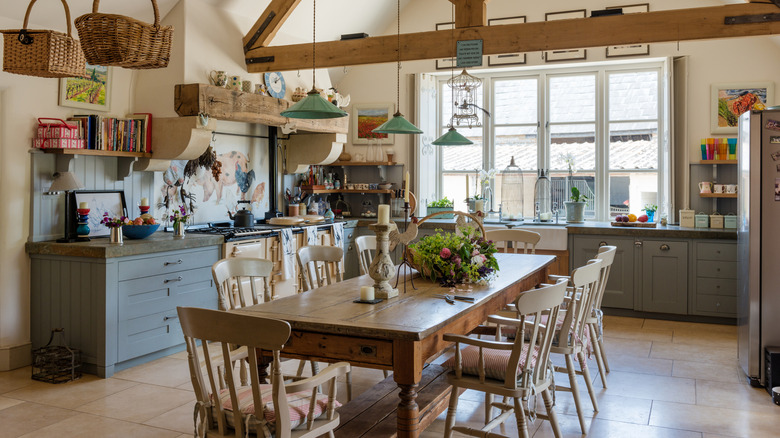The Decades Old Window Treatment That Gives Farmhouse Rustic Vibes
We may receive a commission on purchases made from links.
Classic stripes are always chic and stylish, cropping up in several of today's popular design aesthetics including farmhouse, cottage, and coastal styles. It's a pattern that both makes a statement and remains timeless. One popular variety of striped patterns remains a common element in many interiors, covering everything from pillows and upholstery to window treatments. Ticking stripes, usually identified by slender and closely placed stripes in colors like blue, green, gray, and red, are particularly popular for window treatments and have a long history of dominance in the interior design arena. This familiar pattern can be a great way to cover your windows, especially if you are trying to bring a rustic but sophisticated feel to farmhouse or cottage spaces. Ticking stripes offer a classic charm, adaptability, and richness of pattern unmatched by other stripe varieties.
Using striped ticking on your windows can read as country-inspired, but it can also feel sleek and contemporary depending on what you surround it with. Most often today, you will see it used in French country and modern farmhouse-style spaces with a European touch. The original fabric for ticking, which was largely used for mattresses in the 17th century, was durable, thickly woven, and meant to keep the contents of the mattress (materials like straw, horsehair, and feathers) from poking through. Made of thick flax or cotton twill, it eventually became a popular fabric for other uses that required durability, like aprons and work clothing. The fabric's popularity in America grew during the 1930s when Great Depression-era designer Dorothy "Sister" Parish decided to make it a hallmark of her interior design, including window coverings. Ticking stripes are still popular today for use on windows and elsewhere.
The enduring appeal of ticking stripes
There are many reasons why ticking stripes have prevailed through eras of design. The close proximity of the stripes makes them more subtle than barber-shop, Breton, or circus tent-inspired thicker stripes. This means they are often brought into design schemes as neutral, no matter the color. While they come in both vertical and horizontal orientations, a nice vertical ticking stripe can do wonders for making a window seem taller by directing the eye upwards. A print often associated with French Provincial design, ticking has a classic and sophisticated European feel, making it popular among similarly rustic aesthetics. They can often be paired with sculptural curtain rods and simple ring-hanging hardware for a chic and refined take on rustic style.
If you love using stripes for window treatments, there are many ways it can be mixed with both solids and other patterns, like florals and damask, for an eclectic and minimalist look. Today's ticking can be found in thick upholstery grade and thinner and more delicate fabrics like linen, with many options for stylish window treatments including dramatic floor-length drapes, Roman shades, and cafe curtains. Some beautiful options include Jinchan Linen Kitchen Curtains with a stylish neutral stripe perfect for smaller windows in bathrooms and over the kitchen sink. Or for a slightly bolder and more colorful look, opt for these red-striped Lush Decor Farmhouse Stripe Curtain Panels or Vangao Linen Blend Stripe Curtains that come with multiple stripe color options.

